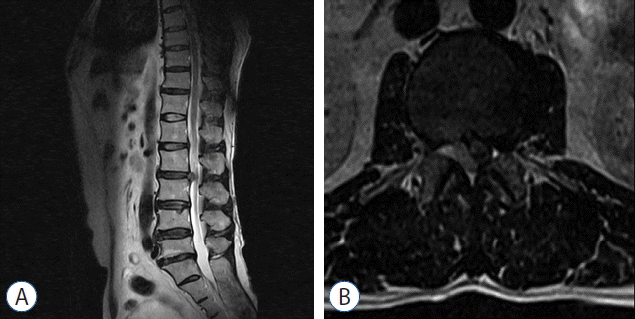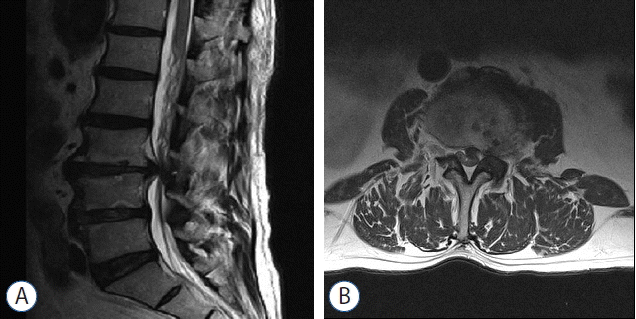This article has been
cited by other articles in ScienceCentral.
Abstract
Objective
This study aimed to unravel the putative mechanism underlying the neurologic deficits contralateral to the side with lumbar disc herniation (LDH) and to elucidate the treatment for this condition.
Methods
From January 2009 to June 2015, 8 patients with LDH with predominantly contralateral neurologic deficits underwent surgical treatment on the side with LDH with or without decompressing the symptomatic side. A retrospective review of charts and radiological records of these 8 patients was performed. The putative mechanisms underlying the associated contralateral neurological deficits, magnetic resonance imaging (MRI), electromyography (EMG), and the adequate surgical approach are discussed here.
Results
MRI revealed a similar laterally skewed paramedian disc herniation, with the apex deviated from the symptomatic side rather than directly compressing the nerve root; this condition may generate a contralateral traction force. EMG revealed radiculopathies in both sides of 6 patients and in the herniated side of 2 patients. Based on EMG findings and the existence of suspicious lateral recess stenosis of the symptomatic side, 6 patients underwent bilateral decompression of nerve roots and 2 were subjected to a microscopic discectomy to treat the asymptomatic disc herniation. No specific conditions such as venous congestion, nerve root anomaly or epidural lipomatosis were observed, which may be considered the putative pathomechanism causing the contralateral neurological deficits. The symptoms resolved significantly after surgery.
Conclusion
The traction force generated on the contralateral side and lateral recess stenosis, rather than direct compression, may cause the contralateral neurologic deficits observed in LDH.
Keywords: Lumbar, Herniated disk, Contralateral
INTRODUCTION
Lumbar disc herniation (LDH) is the most common cause of radiculopathy and myelopathy wherein nerve root compression is on the same side as the presented symptoms. However, spine surgeons have sometimes reported cases of LDH causing predominantly contralateral neurologic deficits.
Contralateral LDH without any significant abnormality on the symptomatic side on radiological studies can be an embarrassing situation, and spine surgeons hesitate to perform surgery due to the risk of failed surgeries.
In these cases, it is difficult to ensure the relief of symptoms without performing a decompression on the symptomatic side. Several authors have reported patients who presented contralateral symptoms caused by LDH
1,
3,
8,
16). However, the exact mechanisms underlying this clinical condition are still not well understood.
In the present study, we report several cases of LDH presented with contralateral symptoms.
The putative mechanisms underlying the clinical features of this condition and the adequate surgical approach to treat this condition are also discussed.
MATERIALS AND METHODS
The present report is a retrospective study performed on the medical charts and radiographic records of patients presenting neurologic deficits contralateral to the side of LDH. From January 2009 to June 2015, 8 patients who showed neurologic deficits contralateral to the side of LDH underwent surgical treatment performed by two surgeons at a single center. Preoperative work-up included plain X-ray imaging, magnetic resonance imaging (MRI), and electromyography (EMG).
The patients (7 men and 1 woman), aged 21–68 years (mean age: 50.0 years), presented lesions ranging from L2–3 to L4–5 levels.
All patients met the following inclusion criteria :
No history of previous lumbar spine surgery
Single-level unilateral LDH presented with predominant contralateral symptoms
No large central type LDH, or significant instability
All patients have been assessed for at least 6 months and their mean follow-up period was 12 months.
The symptoms and signs of the patients, the imaging findings, including those of MRI, EMG, surgical approach, and clinical outcome, were evaluated.
RESULTS
All patients presented with dominant symptoms contralateral to the side of disc herniation. Seven men and 1 woman aged 21 to 68 years (mean age: 50.0 years) were retrospectively analyzed.
The affected levels varied from L2–3 (n=2), L3–4 (n=1) and L4–5 (n=5).
Basic characteristics of the patients are reported in
Table 1. Most patients (7 of 8; 88%) showed similar MRI findings: no direct compression was noted on the herniation and contralateral symptomatic sides; however, the apex of disc herniation was deviated toward the lateral, not medial, part.
Two patients (case 1 and 2) who presented L2–3 disc herniation and both radiculopathies underwent interbody fusion for narrow lamina width (
Fig. 1).
Two patients (case 3 and 4) with pain radiating towards the right leg confirmed with left-side radiculopathy and left-side herniation on EMG underwent microscopic discectomy using the left side interlaminar approach without contralateral fenestration (
Fig. 2). There were no preoperative findings of significant lateral recess stenosis in these 2 patients. Four patients (case 5–8) confirmed with both side radiculopathies on EMG, with suspicious contralateral lateral recess stenosis, underwent microscopic discectomy and fenestration for decompression contralateral to the symptomatic side.
The symptoms and signs improved significantly after surgery. All patients achieved a good, or excellent, outcome according to the modified MacNab’s criteria assessed 6 months after surgery. Comparison of leg pain before and after surgery showed significant improvement in 7 patients after 6 months of surgery. Prior to surgery, the mean leg pain score (visual analogue scale) was 7.2±1.5, which decreased to 2.5±1.0 after 6 months of surgery. In one patient who showed contralateral motor weakness before surgery (case 1), the motor weakness was completely resolved in the 6-month follow-up.
DISCUSSION
It is well known that the presence of LDH on radiological studies is not always the cause of myelopathy or radiculopathy
7,
15).
Especially, the development of MRI can detect the bulges or protrusions in people with low back pain coincidentally. However, the presence of a herniated disc on an imaging study does not guarantee the exact cause of the patient’s symptoms and signs. Most lumbar radiculopathies are caused by root compression, most commonly from herniated lumbar discs or degenerative lumbar spine disease, such as the spinal stenosis or bony hypertrophy. Although MRI is sensitive enough to detect these anatomical changes that cause radiculopathy, this approach cannot provide any information about nerve function, and it cannot inform the surgeon whether these anatomical changes are the sources of the symptoms
14).
Determining whether the herniated disc is the cause of the patient’s presenting symptoms is much more challenging when the imaging studies show LDH on the contralateral side of symptoms.
Although rare, LDH related to contralateral neurologic deficits has been reported by spine surgeons.
In these challenging cases, spine surgeons are confused due to the fact that exact etiology and adequate treatment has not been clarified in the literature. Electrodiagnostic studies may be helpful in this situation because this approach is exquisitely specific; therefore, it is a good complement to MRI, which is a very sensitive, but not specific, test.
Some authors have published reports on contralateral symptoms due to unilateral LDH and their possible factors (
Table 2)
2,
4,
6,
11,
12).
Choudhury et al.
3) have reported three cases of lumbar radiculopathy contralateral to LDH and they explained, for the first time, that the syndrome may be caused by the prominent spondylotic changes and the accompanying stenosis.
However, Kornberg
9) has reported 4 patients with LDH, contralateral radiculopathy, with no evidence of spondylotic change or stenosis.
In the series reported in Mirovsky and Halperin
10), 3 of 5 patients had compression of the contralateral nerve root and both nerve roots were explored by removing the yellow ligament.
However, Sucu and Gelal
13) have reported 5 patients with paracentral LDH with the apex deviated away from the side of contralateral symptoms. They proposed that traction force, rather than direct compression, might be responsible for the contralateral symptoms because the traction force generated on the contralateral root is stronger than the force applied on the ipsilateral nerve root. Therefore, they argued that the selective surgical intervention from the herniation side is sufficient
13).
Friction radiculitis, migrated epidural fat, nerve root anomaly or venous congestion were also discussed as possible causes of the associated contralateral neurological deficits
5,
8,
16).
In our series, we did not observe any anomaly of the nerve root, epidural lipomatosis or venous congestion. Instead, we found a paracentral herniated disc with the apex deviated away from the side of the symptoms on MRI in 7 of the eight discs. In agreement with Sucu and Gelal
13), we believe that the traction force generated on the contralateral nerve root, or the lateral recess stenosis, may be responsible for the contralateral symptoms. Lateral recess stenosis may have an effect on contralateral clinical signs. It has been previously postulated that the compression of the neural structures toward the lateral recess on the contralateral side is more frequent if the herniated disc is larger or if the disc material migrates caudally
5).
Resolution of symptoms and signs in all patients were achieved. EMG findings and the existence of suspicious contralateral lateral stenosis are important to explore and decompress the symptomatic side in addition to discectomy for herniated disc. In the absence of lateral recess stenosis or radiculopathy on EMG on the symptomatic side, bilateral decompression may not be necessary.
CONCLUSION
Contralateral neurologic deficits can be caused by LDH. Traction, rather than direct compression, may cause contralateral neurologic deficits in LDH. Electrodiagnosis as well as MRI can play a complementary role in the diagnosis for symptomatic lumbar radiculopathy.

